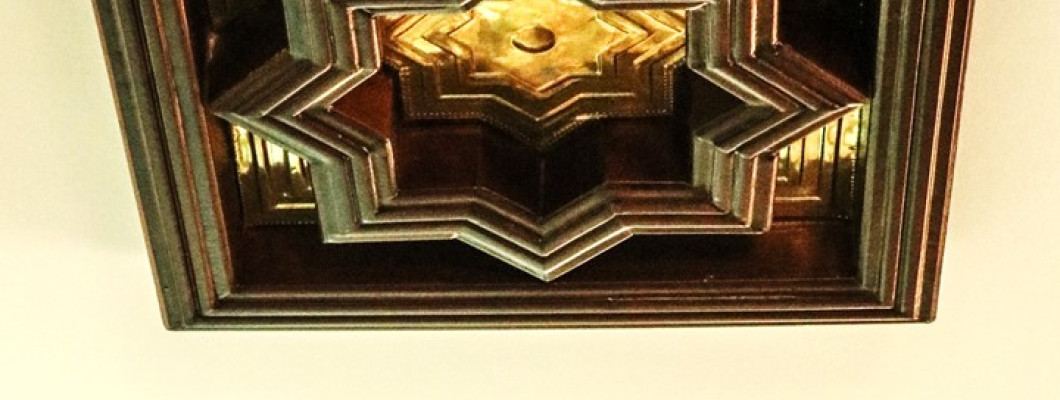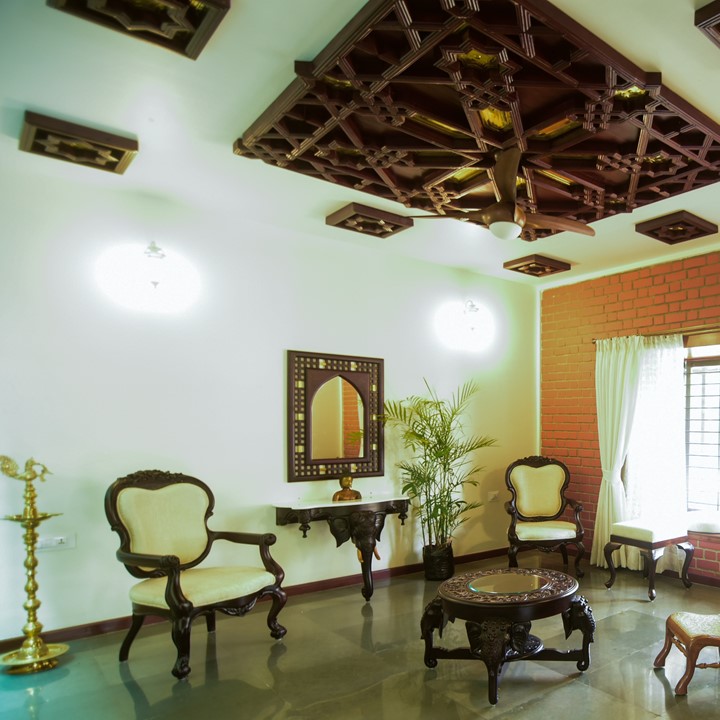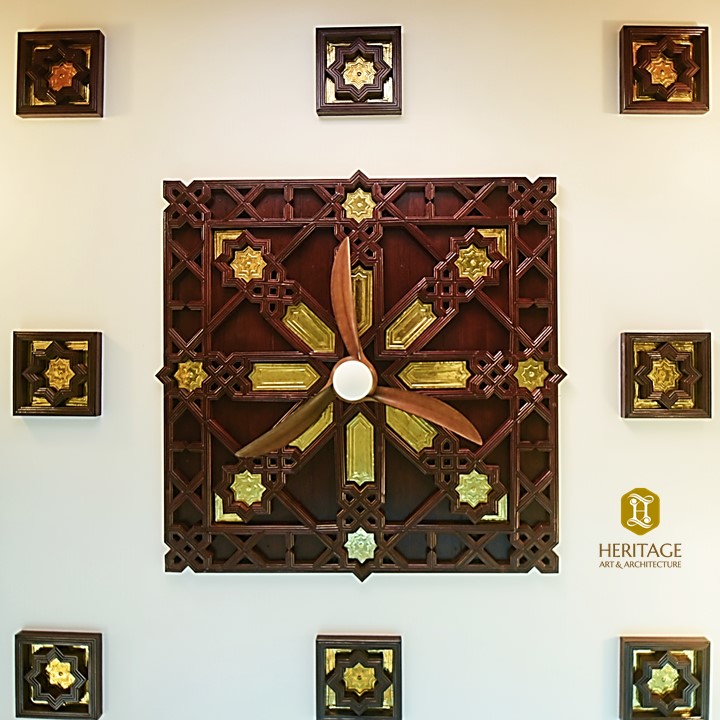
The pursuit of creating a harmonious and visually appealing
living space has been a timeless endeavour for homeowners. In this pursuit for
aesthetic perfection, each element within interior design plays an important
role. Among the various elements that contribute to the overall design, false wooden
ceilings have gained significant importance in recent times. Recognizing the
potential of ceilings as integral design elements ensures that every aspect of
a space is considered and contributes to the harmonious balance of form and
function.
Functions of wooden ceiling designs
False wooden ceilings serve a multitude of practical
purposes beyond merely enclosing a space. The utilitarian aspects of ceilings
are essential for creating comfortable and functional environments. This
architectural element, typically installed beneath the actual structural
ceiling, contributes to the overall functionality and comfort of a space. Here
is a description of the key functions of a false wooden ceiling:
Temperature regulation:
Wood possesses inherent insulating qualities, making it an excellent
choice for maintaining temperature within homes. These wooden ceilings serve as
an extra insulating layer, preventing heat dissipation in colder seasons and
reducing heat absorption during warmer months. This heat barrier helps in
sustaining a steady and pleasant indoor temperature, which, in turn, enhances energy efficiency
and decreases reliance on heating and cooling systems.
Environmental Resilience:
False wooden ceilings demonstrate exceptional versatility in
adapting to various climates and weather conditions. In colder regions, they
help trap and retain heat, fostering a cozy atmosphere within the home.
Conversely, in hotter climates, these ceilings act as a shield against the
sun's direct rays, preventing excessive heat from infiltrating indoor spaces.
This adaptability allows homeowners to create a comfortable living environment
regardless of external weather variations.
Acoustic Benefits:
Beyond their visual appeal, false wooden ceilings also
contribute to improved acoustics within a space. Creating a calm living
environment is facilitated by wood's natural sound-absorbing properties,
effectively diminishing echoes and minimizing noise levels within a space. False
wooden ceilings contribute to a balanced auditory experience, enhancing the
overall comfort of the home. This is particularly advantageous in commercial
settings such as offices, conference rooms, and auditoriums, where effective acoustic
control is essential.
Concealing Utilities:
These ceilings provide an effective means of concealing
utilities such as electrical wiring, ducts, and plumbing. The space between the
structural ceiling and the false wooden ceiling allows for easy access to these
utilities while maintaining a clean and polished appearance in the room below. In
commercial spaces, well-designed ceilings can also accommodate lighting
fixtures, ventilation systems, and other essential infrastructure.
Technological
Integration:
Advancements in technology have expanded the functional
possibilities of ceilings. Smart ceilings equipped with integrated lighting,
audio-visual systems, and climate control contribute to the concept of smart
homes and offices. These ceilings not only enhance convenience but also
underscore the seamless integration of technology into modern living and
working spaces.
Aesthetics of wooden ceiling designs
Wooden false ceilings have a profound impact on the visual
appeal of a space. The design and treatment of a ceiling can drastically alter
the perceived height, size, and atmosphere of a room. High ceilings can impart
a sense of grandeur and openness, while lower ceilings may create a more
intimate and cozy ambiance. Here's a
detailed description of the aesthetic elements that make a false wooden ceiling
visually captivating:
Natural Beauty of Wood: The unique grain
patterns and textures of different wood species contribute to the aesthetic
charm of wooden ceilings. Whether it's the bold and pronounced grains or the
subtle elegance of wood type, the natural beauty of wood adds character to the
ceiling.
Wood has long been associated with warmth and comfort. False
wooden ceilings create an inviting and cozy ambiance within a space. The warm
tones and natural textures of these ceilings add a touch of nature indoors,
making the environment more aesthetically pleasing and particularly beneficial
in creating welcoming atmospheres in different spaces. The natural tones and
textures of wood have a timeless appeal that transcends trends, ensuring a
lasting aesthetic impact.
Additionally, the psychological impact of wooden textures is
well-documented; with studies suggesting that exposure to natural elements can
positively influence mood and well-being. The presence of false wooden ceilings
in a home may contribute to a sense of tranquillity and connection with nature,
promoting a relaxed and harmonious living environment.
Timeless Elegance:
One of the remarkable qualities of false wooden ceilings is
their ability to evoke a timeless and sophisticated ambiance. Unlike trends
that come and go, the classic appeal of wood transcends time, making it a
timeless choice for interior design. False wooden ceilings, whether in the form
of beams, planks, or panels, add a touch of enduring elegance to a home.
This timeless quality not only enhances the longevity of the
aesthetic appeal but also ensures that the investment in false wooden ceilings
remains relevant and stylish for years to come. Homeowners can enjoy a sense of
continuity and consistency in their interior design, creating a space that
feels both contemporary and timeless.
Customization:
One of the remarkable features of false wooden ceilings is
their versatility in design. Wooden panels can be customized to fit a variety
of architectural styles and interior themes. False wooden ceilings provide architects
with a versatile option to enhance the visual appeal of any space. They come in
a variety of styles, finishes, and colors, allowing for a wide range of design
possibilities. Whether one desires a rustic, traditional look or a more modern
and sleek appearance, false wooden ceilings can be tailored to suit diverse
design preferences. This versatility makes them a valuable asset in interior
design, as they can be seamlessly integrated into various architectural styles.
Architectural Elegance:
The architectural elegance of a false wooden ceiling is
often characterized by meticulous craftsmanship. Intricate details, such as
custom carvings, mouldings, and ornate patterns, contribute to the ceiling's
refined appearance, transforming it into a focal point of the room.
Integration of
Lighting:
The interplay between light and wood is a design synergy
that false wooden ceilings leverage to great effect. Recessed lighting, pendant
fixtures, or chandeliers can be seamlessly integrated into these ceilings,
casting a warm and inviting glow throughout the space. The combination of wood
and light creates a visually stunning effect, emphasizing the architectural
beauty of the ceiling and enhancing the overall aesthetic appeal of the home.
Historical
Perspective:
The use of wooden elements in interior design dates back
centuries, with wood being a symbol of craftsmanship, natural beauty, and
durability. In traditional architecture, wooden ceilings were a mark of
prestige and luxury, adorning palaces and stately homes. False wooden ceilings
pay homage to this historical tradition, connecting the modern home to its rich
architectural roots.
Conclusion
The importance of false wooden ceilings in home aesthetics
cannot be overstated. These versatile design elements offer a spectrum of
possibilities, allowing people to customize their spaces. Beyond their visual
appeal, false wooden ceilings contribute to a holistic and inviting atmosphere,
making them a valuable addition to any home seeking a perfect balance between
functionality and aesthetics. As the trend toward natural and sustainable
design continues, false wooden ceilings stand out as a compelling choice for
those seeking to elevate the beauty of their living spaces.
Unique false wooden ceiling designs can serve as focal points, adding character and interest to an otherwise ordinary space. Architects explore innovative approaches, incorporating shapes, patterns, and materials to create visually stunning and distinctive ceilings that contribute to the overall identity of a room.







